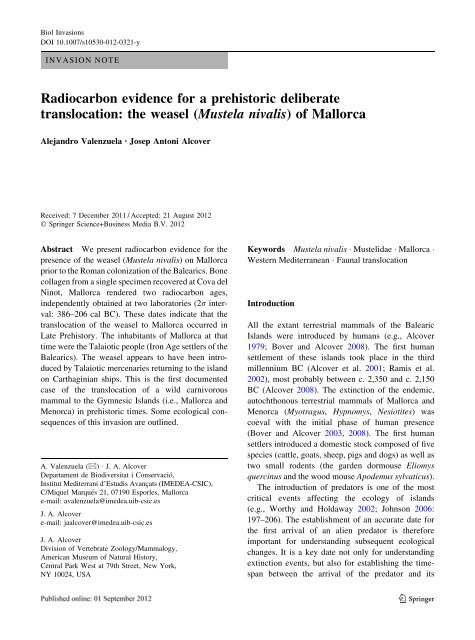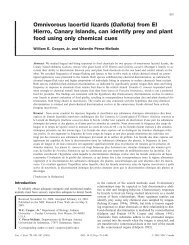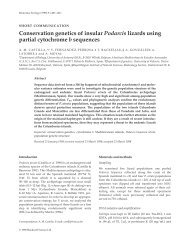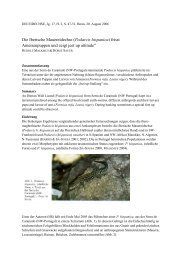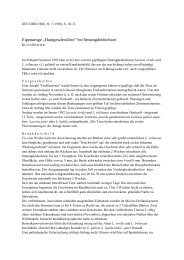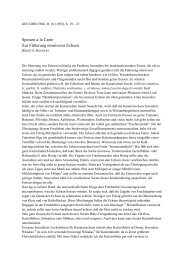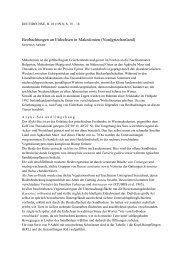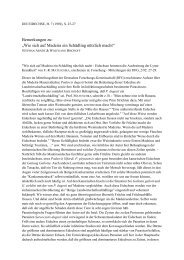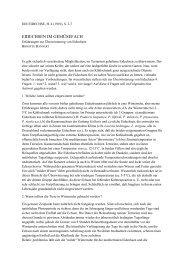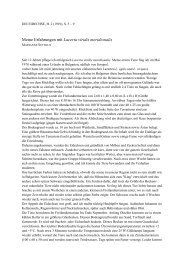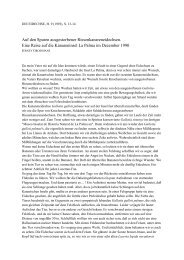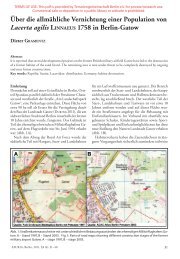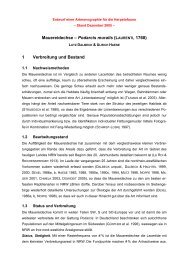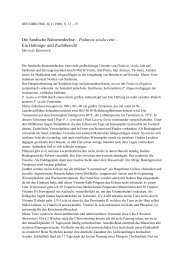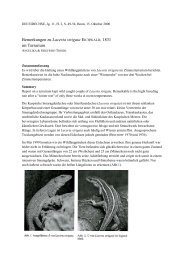the weasel (Mustela nivalis) of Mallorca - Lacerta
the weasel (Mustela nivalis) of Mallorca - Lacerta
the weasel (Mustela nivalis) of Mallorca - Lacerta
Create successful ePaper yourself
Turn your PDF publications into a flip-book with our unique Google optimized e-Paper software.
Biol Invasions<br />
DOI 10.1007/s10530-012-0321-y<br />
INVASION NOTE<br />
Radiocarbon evidence for a prehistoric deliberate<br />
translocation: <strong>the</strong> <strong>weasel</strong> (<strong>Mustela</strong> <strong>nivalis</strong>) <strong>of</strong> <strong>Mallorca</strong><br />
Alejandro Valenzuela • Josep Antoni Alcover<br />
Received: 7 December 2011 / Accepted: 21 August 2012<br />
Ó Springer Science+Business Media B.V. 2012<br />
Abstract We present radiocarbon evidence for <strong>the</strong><br />
presence <strong>of</strong> <strong>the</strong> <strong>weasel</strong> (<strong>Mustela</strong> <strong>nivalis</strong>) on <strong>Mallorca</strong><br />
prior to <strong>the</strong> Roman colonization <strong>of</strong> <strong>the</strong> Balearics. Bone<br />
collagen from a single specimen recovered at Cova del<br />
Ninot, <strong>Mallorca</strong> rendered two radiocarbon ages,<br />
independently obtained at two laboratories (2r interval:<br />
386–206 cal BC). These dates indicate that <strong>the</strong><br />
translocation <strong>of</strong> <strong>the</strong> <strong>weasel</strong> to <strong>Mallorca</strong> occurred in<br />
Late Prehistory. The inhabitants <strong>of</strong> <strong>Mallorca</strong> at that<br />
time were <strong>the</strong> Talaiotic people (Iron Age settlers <strong>of</strong> <strong>the</strong><br />
Balearics). The <strong>weasel</strong> appears to have been introduced<br />
by Talaiotic mercenaries returning to <strong>the</strong> island<br />
on Carthaginian ships. This is <strong>the</strong> first documented<br />
case <strong>of</strong> <strong>the</strong> translocation <strong>of</strong> a wild carnivorous<br />
mammal to <strong>the</strong> Gymnesic Islands (i.e., <strong>Mallorca</strong> and<br />
Menorca) in prehistoric times. Some ecological consequences<br />
<strong>of</strong> this invasion are outlined.<br />
A. Valenzuela (&) J. A. Alcover<br />
Departament de Biodiversitat i Conservació,<br />
Institut Mediterrani d’Estudis Avançats (IMEDEA-CSIC),<br />
C/Miquel Marqués 21, 07190 Esporles, <strong>Mallorca</strong><br />
e-mail: avalenzuela@imedea.uib-csic.es<br />
J. A. Alcover<br />
e-mail: jaalcover@imedea.uib-csic.es<br />
J. A. Alcover<br />
Division <strong>of</strong> Vertebrate Zoology/Mammalogy,<br />
American Museum <strong>of</strong> Natural History,<br />
Central Park West at 79th Street, New York,<br />
NY 10024, USA<br />
Keywords <strong>Mustela</strong> <strong>nivalis</strong> Mustelidae <strong>Mallorca</strong><br />
Western Mediterranean Faunal translocation<br />
Introduction<br />
All <strong>the</strong> extant terrestrial mammals <strong>of</strong> <strong>the</strong> Balearic<br />
Islands were introduced by humans (e.g., Alcover<br />
1979; Bover and Alcover 2008). The first human<br />
settlement <strong>of</strong> <strong>the</strong>se islands took place in <strong>the</strong> third<br />
millennium BC (Alcover et al. 2001; Ramis et al.<br />
2002), most probably between c. 2,350 and c. 2,150<br />
BC (Alcover 2008). The extinction <strong>of</strong> <strong>the</strong> endemic,<br />
autochthonous terrestrial mammals <strong>of</strong> <strong>Mallorca</strong> and<br />
Menorca (Myotragus, Hypnomys, Nesiotites) was<br />
coeval with <strong>the</strong> initial phase <strong>of</strong> human presence<br />
(Bover and Alcover 2003, 2008). The first human<br />
settlers introduced a domestic stock composed <strong>of</strong> five<br />
species (cattle, goats, sheep, pigs and dogs) as well as<br />
two small rodents (<strong>the</strong> garden dormouse Eliomys<br />
quercinus and <strong>the</strong> wood mouse Apodemus sylvaticus).<br />
The introduction <strong>of</strong> predators is one <strong>of</strong> <strong>the</strong> most<br />
critical events affecting <strong>the</strong> ecology <strong>of</strong> islands<br />
(e.g., Worthy and Holdaway 2002; Johnson 2006:<br />
197–206). The establishment <strong>of</strong> an accurate date for<br />
<strong>the</strong> first arrival <strong>of</strong> an alien predator is <strong>the</strong>refore<br />
important for understanding subsequent ecological<br />
changes. It is a key date not only for understanding<br />
extinction events, but also for establishing <strong>the</strong> timespan<br />
between <strong>the</strong> arrival <strong>of</strong> <strong>the</strong> predator and its<br />
123
ultimate consequences (such as <strong>the</strong> chronologies <strong>of</strong><br />
prey extinctions or <strong>of</strong> body size changes in <strong>the</strong><br />
surviving prey species). Until now, <strong>the</strong>re was no<br />
conclusive evidence for <strong>the</strong> presence <strong>of</strong> wild carnivorous<br />
mammals in <strong>the</strong> Balearic Islands in prehistoric<br />
times. Currently, five species <strong>of</strong> carnivores are present<br />
in <strong>Mallorca</strong>, <strong>the</strong> common genet (Genetta genetta), <strong>the</strong><br />
pine marten (Martes martes), <strong>the</strong> <strong>weasel</strong> (<strong>Mustela</strong><br />
<strong>nivalis</strong>), <strong>the</strong> recently established coati (Nasua nasua;<br />
see Álvarez and Mayol 2007) and <strong>the</strong> still questionably<br />
incorporated raccoon (Procyon lotor; see Pinya<br />
et al. 2009). The precise timing <strong>of</strong> <strong>the</strong> introduction <strong>of</strong><br />
<strong>the</strong> first three species has not yet been established. It is<br />
assumed that <strong>the</strong> genet was introduced during <strong>the</strong><br />
Islamic occupation (Alcover 1979), as appears to have<br />
occurred in <strong>the</strong> Iberian Peninsula (Morales 1994). No<br />
data are available on <strong>the</strong> chronology <strong>of</strong> <strong>the</strong> introduction<br />
<strong>of</strong> <strong>the</strong> pine marten on <strong>Mallorca</strong> and Menorca,<br />
although its absence from <strong>the</strong> entire archaeological<br />
record would suggest that it was incorporated in<br />
Modern times Alcover (2010).<br />
The introduction <strong>of</strong> <strong>the</strong> <strong>weasel</strong> to <strong>the</strong> Gymnesic<br />
Islands (<strong>Mallorca</strong> and Menorca) has traditionally been<br />
associated with <strong>the</strong> arrival <strong>of</strong> <strong>the</strong> Romans (e.g.,<br />
Alcover 1979; Sanders and Reumer 1984), although<br />
Morales (2007) claims an earlier presence <strong>of</strong> <strong>the</strong><br />
species on Menorca based on pottery-dated assemblages.<br />
The available isotopic information on <strong>the</strong> first<br />
presence <strong>of</strong> <strong>the</strong> <strong>weasel</strong> on Menorca (Sanders and<br />
Reumer 1984) derives from assumed associations<br />
with 14 C dated charcoal (eight ages) and herbivore<br />
bones (two 14 C ages derived from collagen). Never<strong>the</strong>less,<br />
<strong>the</strong> assumed associations <strong>of</strong> <strong>weasel</strong> bones to<br />
<strong>the</strong> aforementioned pottery-dated assemblages and to<br />
14 C ages are actually inconclusive: charcoal-based<br />
ages have some intrinsic uncertainties (Anderson<br />
1991), <strong>the</strong> stratigraphy proposed by Sanders and<br />
Reumer (1984) was presented only as a proxy, and <strong>the</strong><br />
pottery—associated assemblages are considered to be<br />
insufficient indicators for establishing accurate chronologies<br />
(e.g., Bruins and van der Plicht 2001; Micó<br />
2006).<br />
Thus, <strong>the</strong> total absence <strong>of</strong> directly-dated <strong>weasel</strong><br />
remains means that until now <strong>the</strong> presence <strong>of</strong> wild<br />
carnivores in Balearic Prehistory was speculative.<br />
Here we present direct 14 C dates obtained from<br />
<strong>Mallorca</strong>n <strong>weasel</strong> bones that suggest a change in <strong>the</strong><br />
traditional view on <strong>the</strong> introduction <strong>of</strong> carnivores, <strong>the</strong>ir<br />
cultural framework, and <strong>the</strong>ir ecological consequences.<br />
123<br />
Materials and methods<br />
A. Valenzuela, J. A. Alcover<br />
Remains <strong>of</strong> M. <strong>nivalis</strong> were retrieved from <strong>the</strong><br />
excavation <strong>of</strong> Cova del Ninot (Pollença, <strong>Mallorca</strong>).<br />
The stratigraphic sequence <strong>of</strong> this cave consists <strong>of</strong> flatlying<br />
and unconsolidated sediments deposited as a<br />
result <strong>of</strong> natural and anthropic agents. The intervention<br />
<strong>of</strong> humans in <strong>the</strong> cave took place during brief periods<br />
irregularly scattered throughout <strong>the</strong> Bronze and Iron<br />
Ages. During <strong>the</strong> uninhabited periods, barn owls<br />
inhabited <strong>the</strong> cave and produced layers <strong>of</strong> pellets<br />
containing remains <strong>of</strong> small mammals.<br />
The bones studied here come from <strong>the</strong> stratigraphic<br />
unit UE 300. It is one <strong>of</strong> <strong>the</strong> upper levels <strong>of</strong> <strong>the</strong><br />
sedimentary sequence, and it overlaps <strong>the</strong> stratigraphic<br />
unit UE 3 (<strong>the</strong> most recent archaeological unit). It<br />
comprises a small package composed mainly <strong>of</strong> fine<br />
grained and non-compacted gray clay. O<strong>the</strong>r items<br />
were recovered in association with <strong>the</strong> <strong>weasel</strong> remains.<br />
They include prehistoric pottery, attributed to <strong>the</strong> Late<br />
Iron Age, and bones <strong>of</strong> goat (Capra hircus), wood<br />
mouse (A. sylvaticus) and garden dormouse<br />
(E. quercinus).<br />
The bones <strong>of</strong> M. <strong>nivalis</strong> were identified at <strong>the</strong><br />
Institut Mediterrani d’Estudis Avançats (IMEDEA).<br />
Most probably, <strong>the</strong>y all belong to <strong>the</strong> same adult male<br />
individual, as <strong>the</strong>y come from a very small sedimentary<br />
package and no repeated skeletal elements were<br />
noted.<br />
Two AMS radiocarbon dates were obtained (see<br />
Fig. 1). The first one, from <strong>the</strong> Royal Institute for<br />
Cultural Heritage (Belgium), derives from <strong>the</strong> collagen<br />
<strong>of</strong> a fragment <strong>of</strong> skull, an atlas and a humerus. This<br />
sample was processed by <strong>the</strong> Longin method (Longin<br />
1971) with an extra NaOH cleaning step. Collagen<br />
quality was checked by C/N and % collagen. As it<br />
furnished a 14 C age older than expected, a second date<br />
(on a complete left mandible, presumably <strong>of</strong> <strong>the</strong> same<br />
individual) was obtained in <strong>the</strong> radiocarbon accelerator<br />
unit <strong>of</strong> <strong>the</strong> Research Laboratory for Archaeology<br />
and <strong>the</strong> History <strong>of</strong> Art, University <strong>of</strong> Oxford, UK. This<br />
mandible was initially analysed for collagen remains,<br />
with a small test for measuring % Nitrogen. It was<br />
acceptably well preserved. No difficulties in obtaining<br />
<strong>the</strong> 14 C date were reported. The two dates (Table 1)<br />
were initially analysed separately. Calibration <strong>of</strong> <strong>the</strong><br />
results was obtained using OxCal 4.1.7 (Bronk<br />
Ramsey 1995, 2010) and <strong>the</strong> INTCAL09 calibration<br />
curve (Reimer et al. 2009). Later, both ages were
The <strong>weasel</strong> (<strong>Mustela</strong> <strong>nivalis</strong>) <strong>of</strong> <strong>Mallorca</strong><br />
combined to narrow down <strong>the</strong> chronological range <strong>of</strong><br />
<strong>the</strong> calibrated date.<br />
Results<br />
The 14 C dates obtained are presented, individually and<br />
combined, in Table 1 and Fig. 2. Assuming <strong>the</strong> <strong>weasel</strong><br />
has a totally terrestrial diet, <strong>the</strong>se data point to its<br />
presence on <strong>the</strong> island prior to 206 cal BC. The<br />
Balearic Islands were integrated into <strong>the</strong> Roman<br />
Republic in 123 BC. According to <strong>the</strong>se ages, <strong>the</strong><br />
translocation <strong>of</strong> <strong>the</strong> <strong>weasel</strong> to <strong>Mallorca</strong> was <strong>the</strong> result<br />
<strong>of</strong> a pre-Roman introduction.<br />
This result must be carefully scrutinized. Radiocarbon<br />
ages may be distorted by diet, due to <strong>the</strong> ‘reservoir<br />
effect’ produced by <strong>the</strong> consumption <strong>of</strong> marine food<br />
(e.g., Chisholm et al. 1982; Hobson and Collier 1984).<br />
Although <strong>the</strong>re are no specific studies on <strong>the</strong> diet <strong>of</strong> <strong>the</strong><br />
<strong>weasel</strong> in <strong>the</strong> Balearic Islands, it is known that it preys<br />
mainly on small mammals, especially microtines and<br />
A B<br />
2 cm<br />
Fig. 1 Weasel bones dated from Cova del Ninot. a fragment <strong>of</strong> skull, atlas and humerus (KIA-41154); b complete mandible<br />
(OxA-23737)<br />
Table 1 AMS radiocarbon ages <strong>of</strong> M. <strong>nivalis</strong> from Cova del Ninot<br />
Lab. number Sample<br />
14<br />
C age BP 2r (cal BC)<br />
13<br />
d C(%)<br />
KIA-41154 Skull, atlas, humerus 2,195 ± 40 390–160 BC -19.43<br />
OxA-23737 Complete left jaw 2,246 ± 24 390–208 BC -18.29<br />
Fig. 2 Combined radiocarbon dates <strong>of</strong> <strong>the</strong> <strong>weasel</strong> from Cova<br />
del Ninot<br />
murines (e.g. Day 1968; Tapper 1979; King 1980;<br />
1991; Erlinge 1975). In addition, <strong>the</strong> occasional<br />
consumption <strong>of</strong> birds—both meat and eggs—(Tapper<br />
1979) and <strong>of</strong> lagomorphs (Day 1968; Tapper 1979;<br />
McDonald et al. 2004) has been recorded. O<strong>the</strong>r small<br />
terrestrial vertebrates, insects (mostly beetles), fish,<br />
123
worms, and carrion are taken only very occasionally.<br />
Thus, a terrestrial diet can be assumed for <strong>the</strong> Cova del<br />
Ninot <strong>weasel</strong>. In order to confirm this assumption, <strong>the</strong><br />
available stable 13 C isotopes from <strong>the</strong> dated material<br />
were analyzed. Although <strong>the</strong> two samples correspond<br />
to <strong>the</strong> same individual, <strong>the</strong> d 13 C values obtained are<br />
slightly different: -19.43 ± 0.3 % and -18.29 ±<br />
0.25 % (average: -18.86 %). We compared <strong>the</strong>m<br />
with <strong>the</strong> d 13 C values <strong>of</strong> <strong>the</strong> main putative prey using 4<br />
samples <strong>of</strong> rodents (A. sylvaticus and E. quercinus)<br />
coming from <strong>the</strong> same Cova del Ninot (2 samples) and<br />
from <strong>the</strong> nearby Cova Estreta (2 samples), average:<br />
-19.52 % (extreme values: -19.0 to -20.2 %).<br />
Given that <strong>the</strong> average difference in <strong>the</strong> bone collagen<br />
d 13 C values between terrestrial herbivores and carnivores<br />
is \1 % (Schoeninger and De Niro 1984;<br />
Schoeninger 1985), <strong>the</strong> values obtained for <strong>the</strong> isotopic<br />
signature <strong>of</strong> <strong>the</strong> <strong>weasel</strong> from Cova del Ninot widely<br />
agree with such a diet. The possible effects <strong>of</strong> <strong>the</strong><br />
improbable incorporation <strong>of</strong> some food items <strong>of</strong><br />
marine origin have been checked, following <strong>the</strong><br />
methodology used by Barrett et al. (2000), and using<br />
<strong>the</strong> average value for rodents here presented (i.e.,<br />
-19.52 %) as <strong>the</strong> extreme endpoint for a completely<br />
terrestrial diet. All <strong>the</strong> 14 C dates obtained fall prior to<br />
200 BC. Consequently, it can be established that both<br />
radiocarbon ages unquestionably document that <strong>the</strong><br />
introduction <strong>of</strong> <strong>the</strong> <strong>weasel</strong> took place before this date.<br />
Discussion<br />
According to <strong>the</strong> radiocarbon age obtained, two<br />
possible scenarios arise for <strong>the</strong> introduction <strong>of</strong> <strong>the</strong><br />
<strong>weasel</strong> to <strong>Mallorca</strong>. A first scenario considers <strong>the</strong><br />
Carthaginians as <strong>the</strong> direct agents for <strong>the</strong> translocation.<br />
They traded with <strong>the</strong> prehistoric Talaiotic people <strong>of</strong><br />
<strong>Mallorca</strong> during <strong>the</strong> centuries previous to <strong>the</strong> Roman<br />
occupation (e.g. Ramon 1991; Gómez Bellard 1993;<br />
Guerrero 1999). A second scenario considers <strong>the</strong><br />
Talaiotic people <strong>the</strong>mselves as <strong>the</strong> agents. They<br />
repeatedly acted as mercenaries in <strong>the</strong> Punic Wars<br />
(268–146 BC), primarily as slingers.<br />
The absence <strong>of</strong> <strong>the</strong> <strong>weasel</strong> on Eivissa (Ibiza), an<br />
important Carthaginian colony since 654 BC, precludes<br />
<strong>the</strong> possibility that this island acted as <strong>the</strong> source<br />
region for <strong>the</strong> populations <strong>of</strong> <strong>Mallorca</strong> and Menorca. If<br />
<strong>the</strong> Eivissan Carthaginians had been <strong>the</strong> translocation<br />
agents, especially considering <strong>the</strong> relevant role <strong>of</strong><br />
123<br />
A. Valenzuela, J. A. Alcover<br />
Eivissa in <strong>the</strong> trade with <strong>Mallorca</strong>n prehistoric societies<br />
starting in <strong>the</strong> 4th century BC (e.g. Ramon 1991;<br />
Gómez Bellard 1993; Guerrero, 1999), we would<br />
expect <strong>weasel</strong>s to be present on this island, but no<br />
evidence to this effect has ever been found. Besides,<br />
<strong>the</strong>re is no conclusive evidence <strong>of</strong> direct trade between<br />
<strong>the</strong> remaining Punic colonies (e.g. Carthage, Caralis or<br />
Gadir) and <strong>Mallorca</strong>.<br />
The second scenario points to <strong>the</strong> Talaiotic people<br />
as <strong>the</strong> most probable agents for <strong>the</strong> <strong>weasel</strong>’s translocation.<br />
There is no evidence <strong>of</strong> any Talaiotic naval<br />
technology, and in fact <strong>the</strong> available evidence suggests<br />
that <strong>the</strong> Talaiotics lived mainly with <strong>the</strong>ir backs turned<br />
to <strong>the</strong> sea (Hernández-Gasch et al. 2002; Rihuete<br />
2003; Van Strydonck et al. 2002, 2005). In spite <strong>of</strong><br />
this, those that enrolled as mercenaries with <strong>the</strong><br />
Carthaginians travelled widely throughout <strong>the</strong> Central<br />
and Western Mediterranean during <strong>the</strong> Punic Wars.<br />
Although <strong>the</strong>re is no direct information concerning <strong>the</strong><br />
ultimate fate <strong>of</strong> <strong>the</strong>se Talaiotic slingers, it can be<br />
inferred from some classical authors such as Diodorus<br />
Siculus (Biblio<strong>the</strong>ca Historica V, 16–18), that at least<br />
some <strong>of</strong> <strong>the</strong>m returned to <strong>the</strong> Balearics.<br />
Punic Wars were fought in Sardinia, Sicily, mainland<br />
Italy, <strong>the</strong> Iberian Peninsula and North Africa.<br />
Thus, <strong>the</strong> Talaiotic slingers could have brought <strong>the</strong><br />
<strong>weasel</strong> from any <strong>of</strong> <strong>the</strong>se territories. In this regard, <strong>the</strong><br />
genetics <strong>of</strong> extant <strong>weasel</strong>s could be used to establish<br />
<strong>the</strong> source region. Although <strong>the</strong> biomolecular evidence<br />
is still limited, <strong>the</strong> DNA <strong>of</strong> a Menorcan <strong>weasel</strong><br />
agrees with <strong>the</strong> assignment <strong>of</strong> <strong>the</strong> individual to <strong>the</strong><br />
same sub-clade as <strong>the</strong> Sardinian <strong>weasel</strong>s and differs<br />
from those <strong>of</strong> <strong>the</strong> Western European mainland (Lebarbenchon<br />
et al. 2010). Thus, Sardinia emerges as a<br />
possible source region for <strong>the</strong> Balearic <strong>weasel</strong>.<br />
Unfortunately, <strong>the</strong>re is insufficient information on<br />
<strong>the</strong> DNA <strong>of</strong> <strong>weasel</strong>s from nor<strong>the</strong>rn Africa, leaving<br />
open <strong>the</strong> possibility that both island populations<br />
originated directly from North Africa. In any event,<br />
<strong>the</strong> return <strong>of</strong> <strong>the</strong> Talaiotic slingers with <strong>the</strong>ir accompanying<br />
<strong>weasel</strong>s was necessarily linked to Carthaginian<br />
shipping.<br />
The ultimate causes for <strong>the</strong> translocation are unknown.<br />
Weasels have been introduced in recent times to isolated<br />
territories to control pests (e.g. Terschelling Island,<br />
Ne<strong>the</strong>rlands, de Vos et al. 1956; Australia, New Zealand,<br />
Azores and Sao Tomé, Corbet 1978). It may have been<br />
introduced deliberately on <strong>Mallorca</strong> and Menorca during<br />
Late Prehistory in order to control crop pests.
The <strong>weasel</strong> (<strong>Mustela</strong> <strong>nivalis</strong>) <strong>of</strong> <strong>Mallorca</strong><br />
The Late Iron Age <strong>of</strong> <strong>the</strong> Balearics seems to have<br />
been characterised by an increasing importance <strong>of</strong><br />
agriculture (e.g., Hernández-Gasch et al. 2002). One<br />
<strong>of</strong> <strong>the</strong> main problems <strong>of</strong> agriculture is <strong>the</strong> loss <strong>of</strong> crops<br />
to rodent and lagomorph pests. Some Greek and<br />
Roman writers (e.g. Strabo, Geographica III, 2, 6;<br />
Pliny <strong>the</strong> Elder, Naturalis Historia, VIII, 217) refer to<br />
<strong>the</strong> problems produced by lagomorphs on <strong>the</strong> crops <strong>of</strong><br />
Gymnesic farmers. Likewise, <strong>the</strong> occurrence <strong>of</strong> a<br />
remarkable abundance <strong>of</strong> small mammals during<br />
Prehistory has been suggested on <strong>the</strong> basis <strong>of</strong> high<br />
concentrations <strong>of</strong> small mammals in <strong>the</strong> Prehistoric<br />
sites and <strong>the</strong>ir later absence (Bover and Alcover 2008).<br />
Alternatively, <strong>the</strong> Talaiotic warriors might have<br />
brought <strong>the</strong> <strong>weasel</strong> with <strong>the</strong>m as a pet. Never<strong>the</strong>less,<br />
<strong>the</strong> non-domestication <strong>of</strong> <strong>the</strong> <strong>weasel</strong> makes this option<br />
unlikely.<br />
The introduction <strong>of</strong> <strong>the</strong> <strong>weasel</strong> on <strong>the</strong> Gymnesic<br />
Islands had relevant ecosystemic implications. When<br />
<strong>weasel</strong>s were imported to <strong>Mallorca</strong> and Menorca, <strong>the</strong>y<br />
found an unexpected amount <strong>of</strong> food available, as has<br />
also been pointed out on o<strong>the</strong>r islands when <strong>the</strong> first<br />
alien predator was incorporated (e.g., Worthy and<br />
Holdaway 2002). After <strong>the</strong> arrival <strong>of</strong> <strong>the</strong> <strong>weasel</strong>, <strong>the</strong><br />
endemic Balearic lizard (Podarcis lilfordi) disappeared<br />
from <strong>the</strong> main islands (<strong>Mallorca</strong> and Menorca)<br />
and <strong>the</strong> endemic midwife toad (Alytes muletensis)<br />
became extinct on Menorca and lost more than 95 %<br />
<strong>of</strong> its former distribution on <strong>Mallorca</strong> (Alcover et al.<br />
1981; Sanders and Reumer 1984; Tonge 1986; Moore<br />
et al. 2004). Currently <strong>the</strong> Balearic lizard survives only<br />
on <strong>the</strong> small islets where <strong>weasel</strong>s are not present, while<br />
<strong>the</strong> midwife toad only survives in narrow canyons that<br />
are inaccessible to <strong>weasel</strong>s and o<strong>the</strong>r predatory<br />
mammals. Fur<strong>the</strong>rmore, <strong>the</strong> recorded reduction in<br />
body size between prehistoric and extant populations<br />
<strong>of</strong> wood mice and garden dormice has also been<br />
attributed to <strong>the</strong> introduction <strong>of</strong> <strong>the</strong> <strong>weasel</strong> (e.g.<br />
Sanders 1980; Sanders and Reumer 1984). Additionally,<br />
a decline in <strong>the</strong> population density <strong>of</strong> rodents (and<br />
<strong>of</strong> barn owls as a rebound effect) has also been<br />
attributed to <strong>the</strong> introduction <strong>of</strong> <strong>the</strong> <strong>weasel</strong> (Bover and<br />
Alcover 2008). The combined effect on <strong>the</strong> vegetation<br />
<strong>of</strong> <strong>the</strong> body size reduction and <strong>the</strong> density decline <strong>of</strong><br />
rodents after <strong>the</strong> <strong>weasel</strong>’s arrival is unknown, but some<br />
effect is to be expected. All <strong>the</strong>se ecological changes<br />
evidence a huge transformation <strong>of</strong> <strong>Mallorca</strong>n ecosystems<br />
as a consequence <strong>of</strong> <strong>the</strong> introduction <strong>of</strong> <strong>the</strong> <strong>weasel</strong>.<br />
Conclusion<br />
The radiocarbon ages obtained from bone collagen<br />
present in material recovered from Cova del Ninot<br />
document <strong>the</strong> translocation <strong>of</strong> <strong>the</strong> <strong>weasel</strong> in <strong>the</strong> Late<br />
Prehistory <strong>of</strong> <strong>Mallorca</strong>. These dates are earlier than<br />
those previously documented and exclude <strong>the</strong> Romans<br />
as potential agents <strong>of</strong> <strong>the</strong> translocation. Talaiotic<br />
slingers were <strong>the</strong> most probable agents for this<br />
introduction, although its ultimate cause remains<br />
unresolved. At <strong>the</strong> current state <strong>of</strong> knowledge, <strong>the</strong><br />
<strong>weasel</strong>, which we clearly show to be a Prehistoric<br />
introduction, stands as <strong>the</strong> first wild carnivore to reach<br />
<strong>the</strong> Gymnesic Islands. Its arrival affected <strong>the</strong> structure<br />
<strong>of</strong> <strong>the</strong> existing ecological communities, and it became<br />
a keystone species in <strong>the</strong> reconfigured ecosystems.<br />
Acknowledgments This paper is included in <strong>the</strong> Research<br />
Project CGL2010-17889 <strong>of</strong> <strong>the</strong> Dirección General de<br />
Investigación, Ministerio de Ciencia y Tecnología (Madrid).<br />
We acknowledge <strong>the</strong> help <strong>of</strong> Dr. Christopher Bronk Ramsey and<br />
Dr. Thomas Higham (Oxford) as well as Mr. Mathieu Boudin<br />
and Dr. Mark van Strydonck (Brussels) who provided valuable<br />
supplementary information on different radiocarbon ages. We<br />
also thank Maria Soledad Gogorza for her assistance with <strong>the</strong><br />
manuscript review. Hannah Bonner revised <strong>the</strong> English text.<br />
One <strong>of</strong> <strong>the</strong> authors (A.V.) has a JAE-Predoc fellowship from <strong>the</strong><br />
Consejo Superior de Investigaciones Científicas <strong>of</strong> <strong>the</strong><br />
Ministerio de Educación y Ciencia <strong>of</strong> Spain.<br />
References<br />
Alcover JA (1979) Els mamífers de les Illes Balears. Editorial<br />
Moll, Palma de <strong>Mallorca</strong><br />
Alcover JA (2008) The first mallorcans: prehistoric colonization<br />
in <strong>the</strong> Western Mediterranean. J World Prehist 21:19–84<br />
Alcover JA (2010) Introduccions de mamífers a les Balears:<br />
L’establiment d’un nou ordre. In: Álvarez C (ed) Seminari<br />
sobre espècies introduïdes i invasores a les Illes Balears.<br />
Govern de les Illes Balears, Sóller, pp 175–186<br />
Alcover JA, Moyà-Solà S, Pons-Moyà J (1981) Les Quimeres<br />
del passat. Els vertebrats fossils del Plio-Quaternari de les<br />
Balears i Pitiüses. Editorial Moll, Palma<br />
Alcover JA, Ramis D, Coll J, Trias M (2001) Bases per al<br />
coneixement del contacte entre els primers colonitzadors<br />
humans i la naturalesa de les Balears. Endins 24:5–57<br />
Álvarez CM, Mayol J (2007) El coatí Nasua nasua (L. 1766),<br />
especie invasora naturalizada en <strong>Mallorca</strong>. In: Resúmenes<br />
VIII Jornadas de la SECEM, Huelva, pp 7<br />
Anderson A (1991) The chronology <strong>of</strong> colonization in New<br />
Zealand. Antiquity 65:767–795<br />
Barrett JH, Beukens RP, Brothwell DR (2000) Radiocarbon<br />
dating and marine reservoir correction <strong>of</strong> Viking age<br />
Christian burials from Orkney. Antiquity 74:537–543<br />
123
Bover P, Alcover JA (2003) Understanding late quaternary<br />
extinctions: <strong>the</strong> case <strong>of</strong> Myotragus balearicus (Bate 1909).<br />
J Biogeogr 30:771–781<br />
Bover P, Alcover JA (2008) Extinction <strong>of</strong> <strong>the</strong> autochthonous<br />
small mammals <strong>of</strong> <strong>Mallorca</strong> (Gymnesic Islands, Western<br />
Mediterranean) and its ecological consequences. J Biogeogr<br />
35:1112–1122<br />
Bronk Ramsey C (1995) Radiocarbon calibration and analysis <strong>of</strong><br />
stratigraphy: <strong>the</strong> oxcal program. Radiocarbon 37:425–430<br />
Bronk Ramsey C (2010) OxCal Program v4.1. Available at<br />
https://c14.arch.ox.ac.uk/login/login.php?Location=/oxcal/<br />
OxCal.html<br />
Bruins HJ, van der Plicht J (2001) Radiocarbon challenges<br />
archaeo-historical time frameworks in <strong>the</strong> Near East: <strong>the</strong><br />
Early Bronze Age <strong>of</strong> Jericho in relation to Egypt. Radiocarbon<br />
43:1321–1332<br />
Chisholm BS, Nelson DE, Schwarcz HP (1982) Stable-carbon<br />
isotope ratios as a measure <strong>of</strong> marine versus terrestrial<br />
protein in ancient diets. Science 216:1131–1132<br />
Corbet GB (1978) The mammals <strong>of</strong> <strong>the</strong> palaearctic region: a<br />
taxonomic review. Cornell University Press, London<br />
Day MG (1968) Food habits <strong>of</strong> british stoats (<strong>Mustela</strong> erminea)<br />
and <strong>weasel</strong>s (<strong>Mustela</strong> <strong>nivalis</strong>). J Zool 155:485–497<br />
De Vos A, Manville RH, Van Gelder RG (1956) Introduced<br />
mammals and <strong>the</strong>ir influence on native biota. Zoologica<br />
41:163–194<br />
Erlinge S (1975) Feeding habits <strong>of</strong> <strong>the</strong> <strong>weasel</strong> <strong>Mustela</strong> <strong>nivalis</strong> in<br />
relation to prey abundance. Oikos 26:378–384<br />
Gómez Bellard C (1993) Relaciones comerciales en las islas<br />
Baleares entre los siglos VII y II aC. Cuadernos de Arqueología<br />
Mediterránea 2:159–174<br />
Guerrero VM (1999) Cerámica a torno en la protohistoria de<br />
<strong>Mallorca</strong> (s. VI-I aC). BAR International Series, 770. Oxford<br />
Hernández-Gasch J, Nadal J, Malgosa A, Alesán A, Juan J<br />
(2002) Economic strategies and limited resources in <strong>the</strong><br />
Balearic insular ecosystem: <strong>the</strong> myth <strong>of</strong> an indigenous<br />
animal farming society in <strong>the</strong> First Millennium BC. In:<br />
Waldren WH, Ensenyat JA (eds) World Islands in Prehistory.<br />
International Insular Investigations. BAR International<br />
Series, 1095. Oxford, pp 275–291<br />
Hobson KA, Collier S (1984) Marine and terrestrial protein in<br />
Australian Aboriginal diets. Current Anthropology 25:238–240<br />
Johnson C (2006) Australia’s mammal extinctions: a 50,000 year<br />
history. Cambridge University Press, Cambridge<br />
King CM (1980) Population biology <strong>of</strong> <strong>the</strong> <strong>weasel</strong> <strong>Mustela</strong> <strong>nivalis</strong><br />
on British game estates. Holarctic Ecol 3:160–168<br />
King CM (1991) Weasels. In: Corbet GB, Harris S (eds) The<br />
handbook <strong>of</strong> British mammals. Blackwell Scientific Publications,<br />
Oxford, pp 387–396<br />
Lebarbenchon C, Poitevin F et al (2010) Phylogeography <strong>of</strong> <strong>the</strong><br />
<strong>weasel</strong> (<strong>Mustela</strong> <strong>nivalis</strong>) in <strong>the</strong> western-palaearctic region:<br />
combined effects <strong>of</strong> glacial events and human movements.<br />
Heredity 105:449–462<br />
Longin R (1971) New method <strong>of</strong> collagen extraction for<br />
radiocarbon dating. Nature 230:241–242<br />
McDonald DW, Tew TE, Todd IA (2004) The ecology <strong>of</strong><br />
<strong>weasel</strong>s (<strong>Mustela</strong> <strong>nivalis</strong>) on mixed farmland in sou<strong>the</strong>rn<br />
England. Biologia Bratislava 59:235–241<br />
Micó R (2006) Radiocarbon dating and balearic prehistory:<br />
reviewing <strong>the</strong> periodization <strong>of</strong> <strong>the</strong> prehistoric sequence.<br />
Radiocarbon 48:421–434<br />
123<br />
A. Valenzuela, J. A. Alcover<br />
Moore RD, Griffiths RA, Roman A (2004) Distribution <strong>of</strong> <strong>the</strong><br />
<strong>Mallorca</strong>n midwife toad (Alytes muletensis) in relation to<br />
landscape topography and introduced predators. Biol<br />
Conserv 116:327–332<br />
Morales A (1994) Earliest genets in europe. Nature 370:<br />
512–513<br />
Morales JV (2007) Estudi zooarqueològic dels jaciments talaiòtics<br />
de Biniparratx Petit i Talatí de Dalt (Menorca).<br />
Dissertation, Universitat de València<br />
Pinya S, Perelló E, Álvarez C (2009) Sobre la presencia del<br />
mapache Procyonlotor (Linnaeus 1758) en la isla de<br />
<strong>Mallorca</strong>. Galemys 21:61–64<br />
Ramis D, Alcover JA, Coll J, Trias M (2002) The chronology <strong>of</strong><br />
<strong>the</strong> first settlement <strong>of</strong> <strong>the</strong> Balearic Islands. J Mediterr<br />
Archaeol 15:3–24<br />
Ramon J (1991) Las ánforas púnicas de Ibiza. Trabajos del<br />
Museo Arqueológico de Ibiza 23, Eivissa<br />
Reimer PJ, Baillie MGL, Bard E et al (2009) Intcal09 and Marine09<br />
radiocarbon age calibration curves, 0–50,000 years<br />
cal BP. Radiocarbon 51:1111–1150<br />
Rihuete C (2003) Bio-arqueología de las prácticas funerarias.<br />
Análisis de la comunidad enterrada en el cementerio de la<br />
Cova des Càrritx (Ciutadella, Menorca), ca. 1450–800 cal<br />
ANE, BAR International Series 1161, Oxford<br />
Sanders EAC (1980) The animals found in <strong>the</strong> cave <strong>of</strong> Son<br />
Boronat (<strong>Mallorca</strong>) and some preliminary notes on possible<br />
changes in <strong>the</strong> subrecent rodent populations <strong>of</strong> <strong>Mallorca</strong>.<br />
Bol Soc Arq Lul liana 37:51–58<br />
Sanders EAC, Reumer JWF (1984) The influence <strong>of</strong> prehistoric<br />
and Roman migrations on <strong>the</strong> vertebrate fauna <strong>of</strong> Menorca<br />
(Spain). In: Waldren WH, Chapman R, Lewthwaite J,<br />
Kennard R (eds) The Deya conference <strong>of</strong> prehistory: early<br />
settlement in <strong>the</strong> Western Mediterranean Islands and <strong>the</strong>ir<br />
peripheral areas. BAR International Series 229, Oxford,<br />
pp 119–144<br />
Schoeninger MJ (1985) Trophic level effects on 15 N/14 N and<br />
13C/12C ratios in bone collagen and strontium levels in<br />
bone mineral. J Hum Evol 14:515–525<br />
Schoeninger MJ, De Niro MJ (1984) Nitrogen and carbon isotopic<br />
composition <strong>of</strong> bone collagen from marine and terrestrial<br />
animals. Geochim Cosmochim Acta 48:625–639<br />
Tapper S (1979) The efect <strong>of</strong> fluctuating vole numbers (Microtus<br />
agrestis) on a population <strong>of</strong> <strong>weasel</strong>s (<strong>Mustela</strong> <strong>nivalis</strong>)<br />
on farmland. J Anim Ecol 48:603–617<br />
Tonge S (1986) Collecting <strong>the</strong> mallorcan midwife toad. Oryx<br />
20:4–78<br />
Van Strydonck M, Boudin M, Ervynck A (2002) Stable isotopes<br />
(13C and 15 N) and diet: animal and human bone collagen<br />
from prehistoric sites on <strong>Mallorca</strong>, Menorca and Formentera<br />
(Balearic Islands, Spain). In: Waldren WH, Ensenyat<br />
JA (eds) World Islands in Prehistory. International Insular<br />
Investigations, BAR International Series 1095, Oxford,<br />
pp 189–197<br />
Van Strydonck M, Boudin M, Ervynck A, Orvay J, Borms H<br />
(2005) Spatial and temporal variation <strong>of</strong> dietary habits<br />
during <strong>the</strong> prehistory <strong>of</strong> <strong>the</strong> Balearic Islands as reflected by<br />
14C, d15 N and d13C analyses on human and animal<br />
bones. Mayurqa 30:523–541<br />
Worthy TH, Holdaway RN (2002) The lost world <strong>of</strong> <strong>the</strong> Moa:<br />
prehistoric life <strong>of</strong> New Zealand. Indiana University Press,<br />
Indiana


